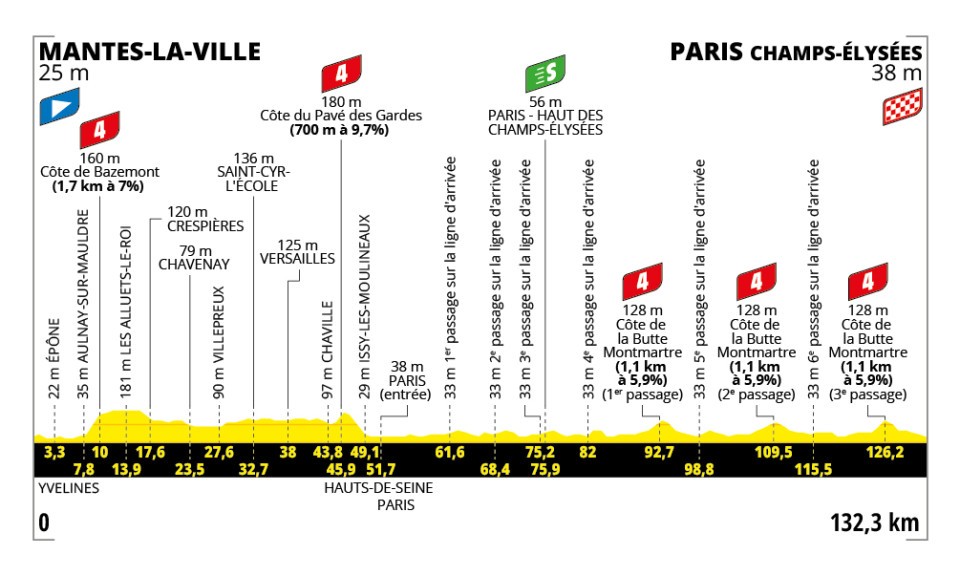Tour de France 2025 stages and route
The Tour de France grand depart is right around the corner, and it is time to take a closer look at the Tour de France 2025 stages and route. In this piece, we take a closer look at all the stages and give you stage profiles and insight into this year’s route.
The 2025 Tour de France Route
In 2025, the Tour de France route is 100 percent French. For the first time since 2020, the race doesn’t cross any international borders. However, it does visit 11 regions and 34 departments across France.
The race starts in the very Northeastern corner of the country, near the Belgian border, and then continues west by the English Channel over the first week.
After a thrilling 7th stage that finishes on Mur-De-Bretagne, the peloton travels south where the mountains arrive.
The 21 Tour de France stages contain seven flat stages, six hilly stages and six mountain stages, five of them finishing on mountains, and two-time trials as well as two rest days.
The Tour de France 2025 route takes the peloton across mountains from all four of France’s big mountain ranges, Massif Central, The Pyrenees, The Alps and the Jura, with the Col de la Loze being the highest point on the route with its 2,304 meters.
Tour de France stages 2025
Below you can find the stage profiles for all 21 stages of the 2025 Tour de France. We’ll analyse the profiles and help you pick the winners. Odds for each stage winner will updated as soon as they are published by the top Australian betting sites.
Stage 1: Lille Metropole – Lille Metropole
The tour kicks off in Lille with a flat stage. Most likely, the stage will end in a bunch sprint, meaning we’ll get a sprinter in the yellow jersey. It is an opportunity that doesn’t arrive often for the sprinters, and they have marked this stage as the most important of the race. The last time the first stage of the Tour de France ended in a bunch sprint was in 2020, when Alexander Kristoff won.
The first stage contains three category 4 climbs, but with the last one being 45 kilometres from the finish line and the finish being flat as a pancake, it is highly unlikely that a breakaway can stay ahead of the peloton.
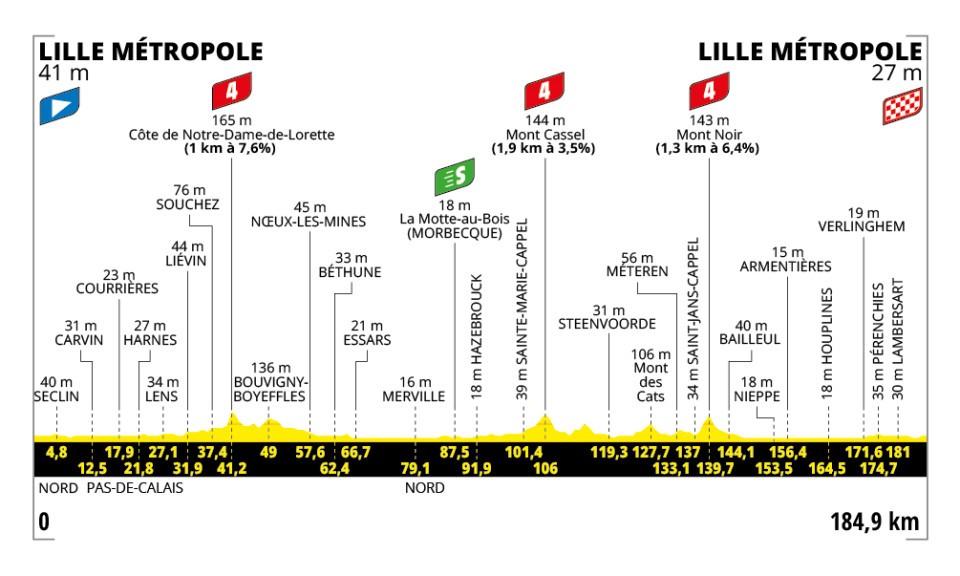
Stage 2: Lauwin-Planque – Boulogne-Sur-Mer
Whoever takes the yellow jersey on the first stage, is likely to lose it on the second already. This is a hilly and exciting stage, which suits the strong puncheurs of the race.
The stage has four categorised climbs, two category four and two category three, and it finishes on a one-kilometre category four climb towards Boulogne-Sur-Mer.
Three of the four categorized climbs are within the last 25 kilometres, and the climb to Cote de Saint-Etienne is just three kilometres from the finish line.
The winner will be found on the final climb, and it will be a rider that combines explosive accelerations with climbing skills on short, but incredibly steep hills.
Tadej Pogacar is the big favourite here.
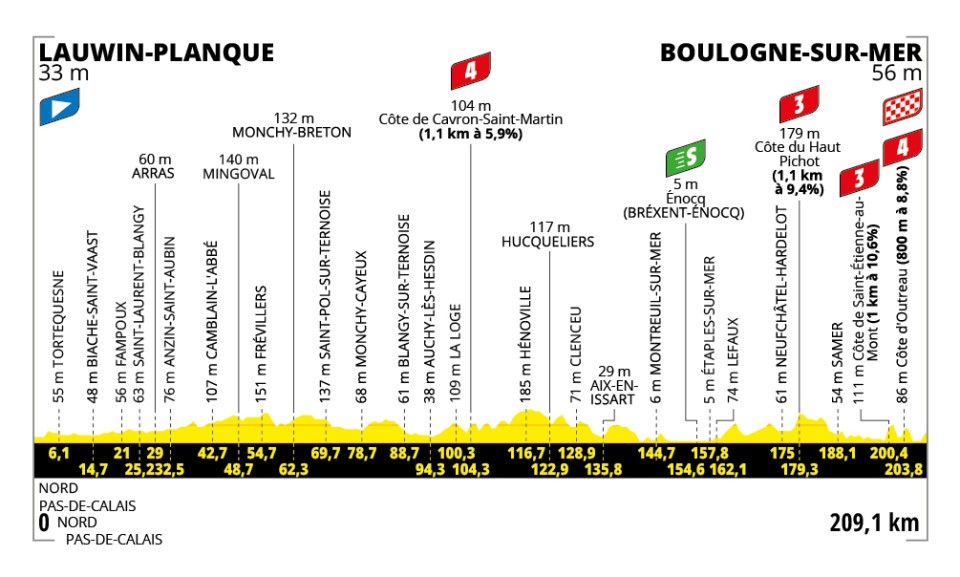
Stage 3: Valenciennes – Dunkerque
Following the exciting previous stage, the riders return to a more predictable terrain with another flat stage. This stage is flat and easy – but only on paper.
The finish could be very interesting if the weather allows it. The final 35 kilometres are in open terrain and if the wind comes from the right direction and with the right power, it can blow the peloton wide open and turn this flat stage into a fight for vital seconds in the GC.
In case the wind doesn’t play a role, this will be a bunch sprint at the finish line.
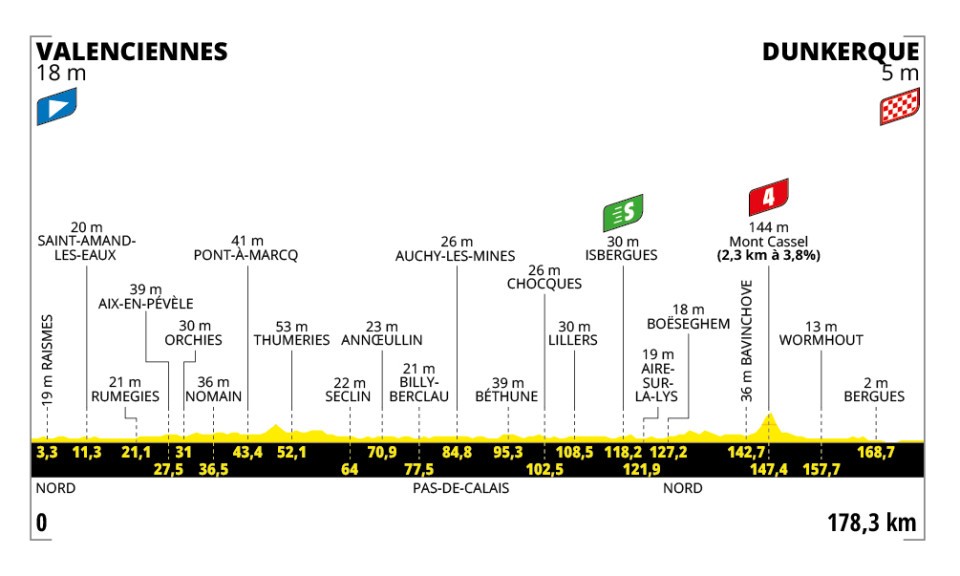
Stage 4: Amiens Metropole – Rouen
The fourth stage of the Tour de France 2025 is one of the more unpredictable in this year’s race. It is hilly from start to finish and boasts five categorized hills in the last 50 kilometres. The final, Rampe Saint-Hilaire (category 3), has the top just five kilometres from the finish line.
The opening of the stage, at the Picardy plain, is also exposed to the wind, which means the riders need to be extra aware not to be caught sleeping in the back.
Even though it doesn’t finish uphill, the stage is too hard for the heavier sprinters to survive to the finish line. Expect a breakaway between the strongest puncheurs to fight for the breakaway.
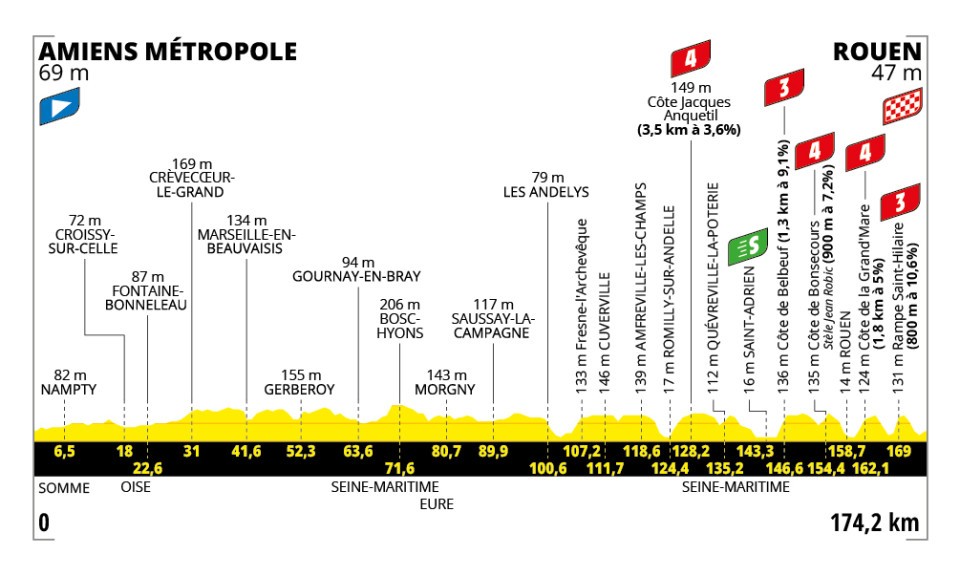
Stage 5: Caen – Caen (ITT)
On the fifth stage, it is time for the first individual time trial of the Tour de France. The route is simple, and it suits the specialists perfectly. Most of the day is spent on wide and straight roads, which means the time trial specialists are in their right element.
When looking at the Tour de France odds, one should look towards the favourites here as we rarely get surprises on a stage like this. However, keep an eye on the weather report as rain can heavily alter the odds.
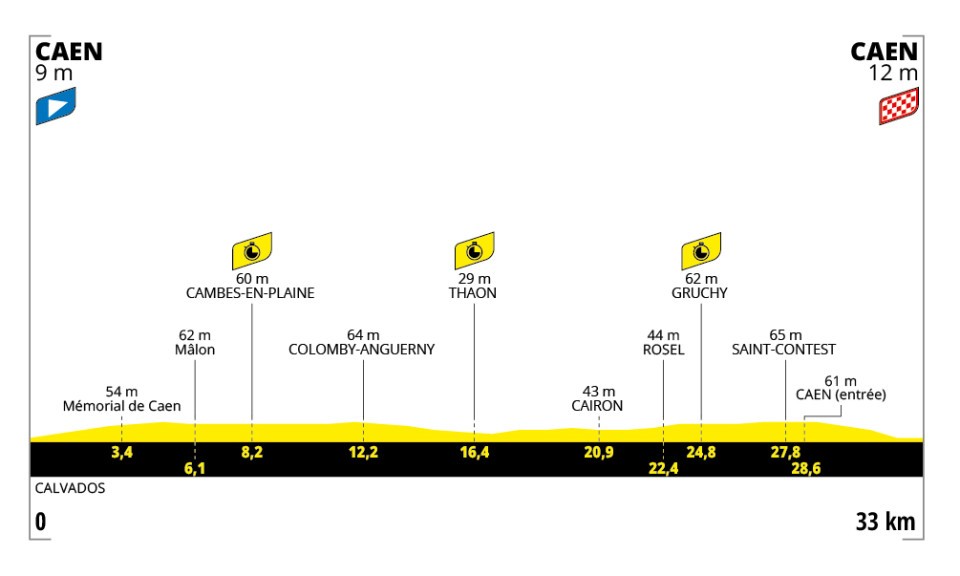
Stage 6: Bayeux – Vire Normandie
The sixth stage looks to be another interesting one. We are in the hilly terrain of Normandie with six categorized climbs here. Five of them are category three and the final, four kilometres from the finish line, is a category four.
The stage is described as “the most challenging flat stage in the Tour’s history”, with more than 3,500 metres of vertical gain. The final climb, Cote de Vaudry, is 1.2 kilometres long with an average elevation of 7.2 %.
Once again, look for the puncheurs when placing your Tour de France bets, but keep an eye on the outsiders that will go in the early breakaway. If either Jonas Vingegaard or Tadej Pogacar is in the yellow jersey after the time trial, they likely won’t mind giving it away here and could let a breakaway slide away.
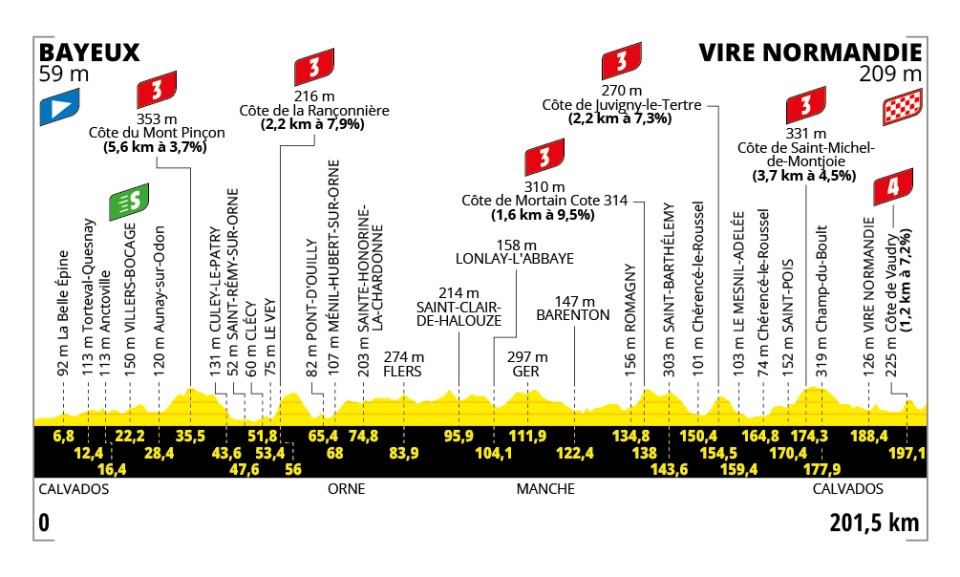
Stage 7: Saint-Malo – Mur-de-Bretagne Guerledan
After a flat start to the stage, it explodes towards the end. We stay in hilly territory with three categorized climbs and finish on the legendary Mur-de-Bretagne.
This is yet another stage for the puncheurs with the final climb being two kilometres and 6.9 %. Although the Mur-de-Bretagne climb is short, it is incredibly hard with some very steep sections. The riders need to be tactical here and spend their energy at the right moment. We have often in the past seen riders attack too early on this climb only to get caught and lose time.
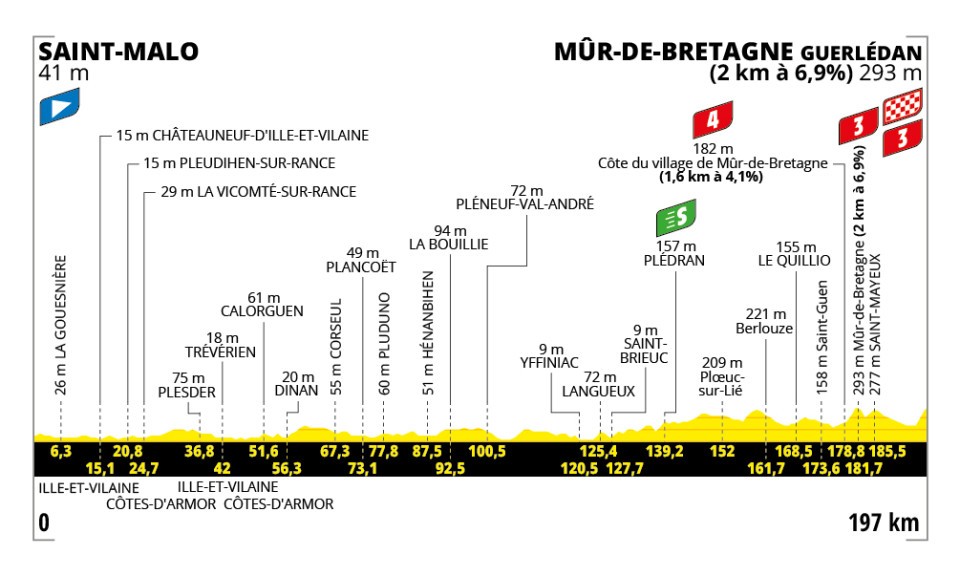
Stage 8: Saint-Méen-Le-Grand – Laval Espace Mayenne
The eight stage of the Tour de France is flat as a pancake. There is one category four climb with 16 kilometres to the finish line, which means it is likely too far away for it to be impactful on the final outcome.
The roads here are mostly sheltered from the wind as well, so there are nothing distracting the peloton from the expected bunch sprint.
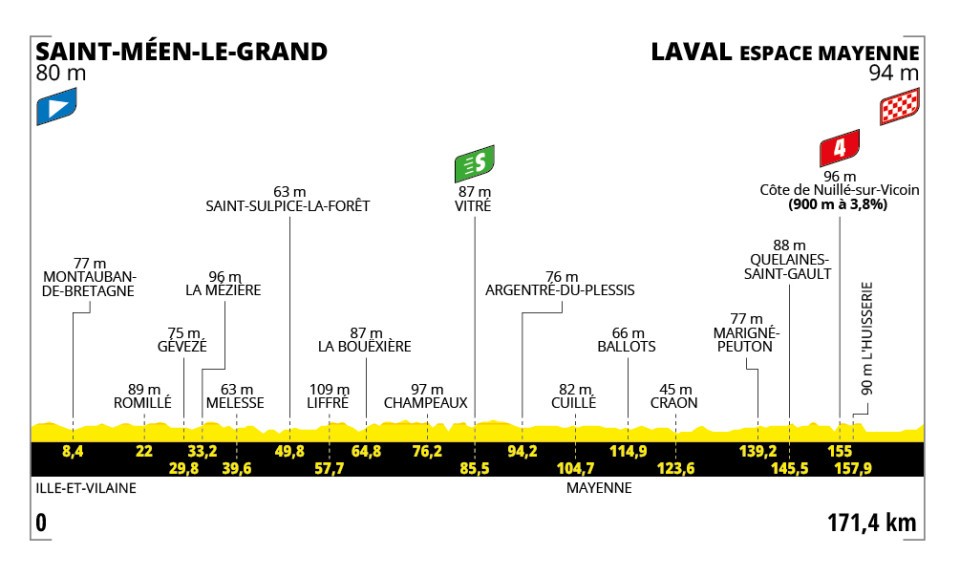
Stage 9: Chinon – Chateauroux
Once again, the Tour de France peloton is in for a slow and relaxing day. On the 158 kilometres stage from Chinon to Chateauroux there isn’t a single categorized climb, and it is thus all about the bunch sprint at the end.
With a tough mountain stage coming up, many riders are likely to try and conserve energy before the upcoming struggles.
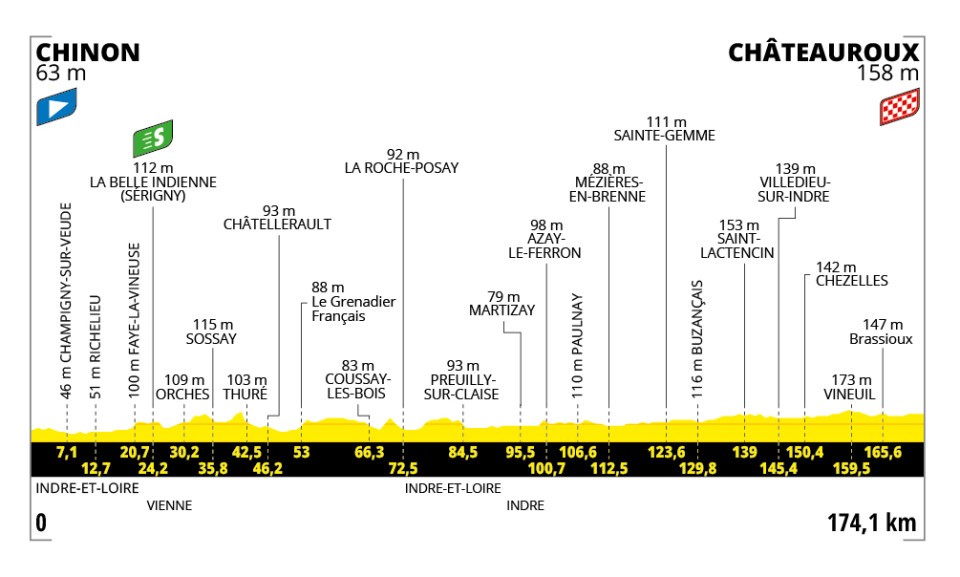
Stage 10: Ennezat – Le Mont-Dore Puy de Sancy
It is finally time for mountains with eight categorized climbs. The peloton starts climbing immediately with the first mountain starting after just 5.7 kilometres.
Seven of the climbs are category 2 and the last is category three. It is up and down the whole day, so while none of the mountains are among the hardest of the race, there is no time to rest and recover. The stage ends on Le Mont-Dore (3.3 kilometre at 8 %).
It is also Bastille Day, France’s national day, so we expect the French riders to be aggressive today.
After this stage, a rest day awaits, which should only boost the aggressiveness of the riders that hope to hit the breakaway.
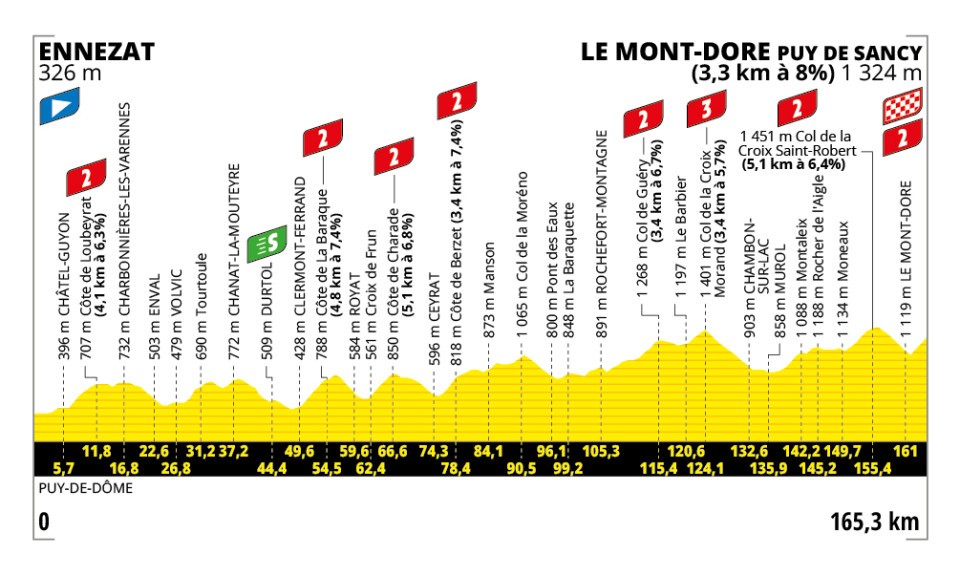
Stage 11: Toulouse – Toulouse
The riders get almost another rest day here with a flat stage. There are four category 4 climbs and a category 3 eight kilometres before the finish line. However, this should still be a bunch sprint.
The combination of the mountain stage the day before and the steep last climb could mean that some of the heavier sprinters won’t have the legs to win today though.
The final climb could also be an opportunity for a puncheur with strong legs like Mathieu van der Poel to launch a surprise attack.
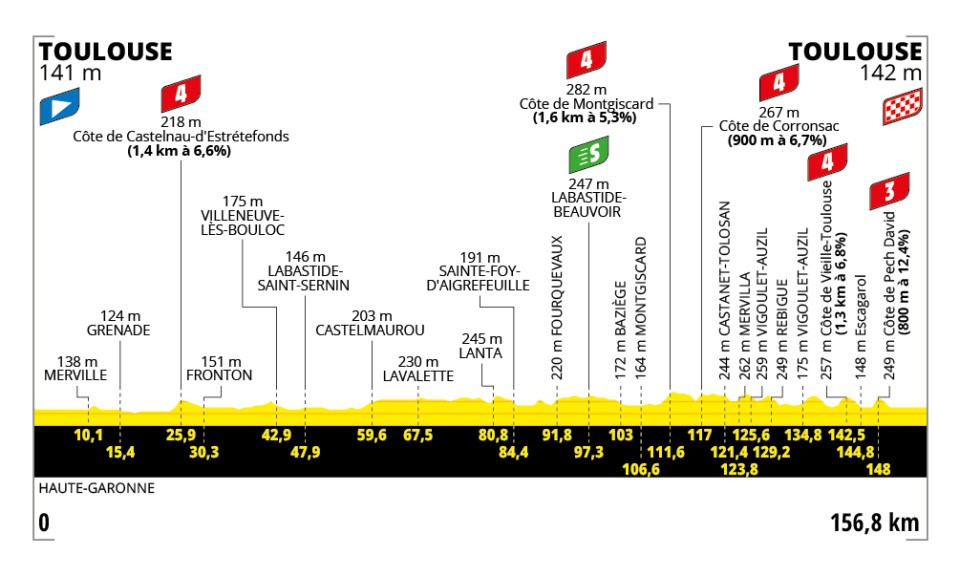
Stage 12: Auch – Hautacam
The peloton returns to the mountains with a tough stage to Hautacam. After a flat first half of the stage, the second half explodes with three mountains. First up is the Col du Soulor (category 1, 11.8 kilometres, 7.3 %), followed by category 2 Col des Borderes (3.1 kilometres, 7.7 %) before legendary Hautacam aways with the finish line.
Hautacam is 13.5 kilometres (7.8 %) and is the first HC mountain of the year. This is a stage for the best climbers in the race, and it will be impossible for the contenders to hide.
Jonas Vingegaard won at Hautacam on his way to his first Tour de France victory in 2022. It is the type of finish that suits the punchy climbers, like Vingegaard, over those who prefer a more steady climb like Remco Evenepoel.
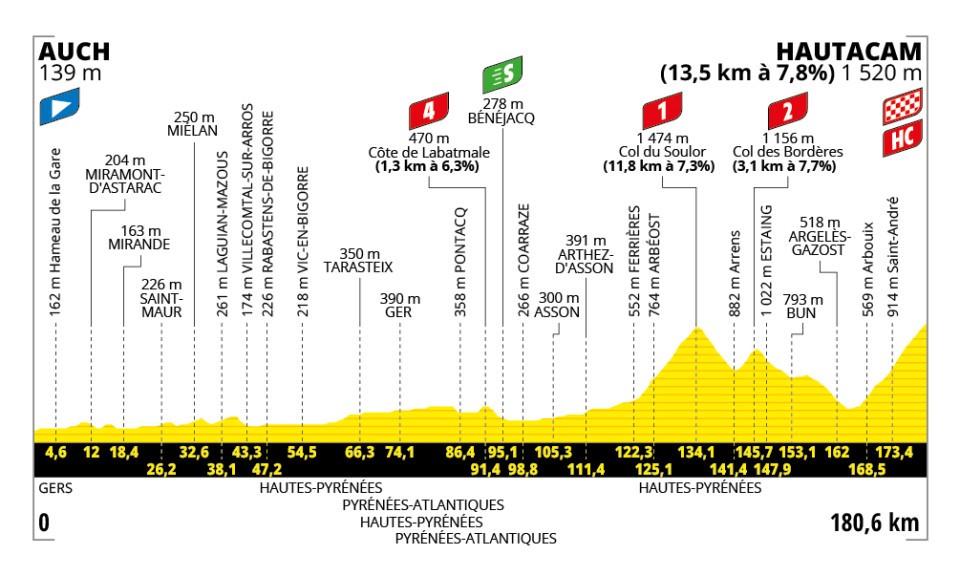
Stage 13: Loudenvielle – Peyragudes (ITT)
The 13th Tour de France stage is yet another individual time trial. This time though, it is on a mountain up to Peyragudes.
The stage is only 10.9 kilometres long, but it is uphill all the way with an average of 7.9 %, so there are no places to rest along the way. This should be a formidable and entertaining time trial where only the best climbers has a chance to win.
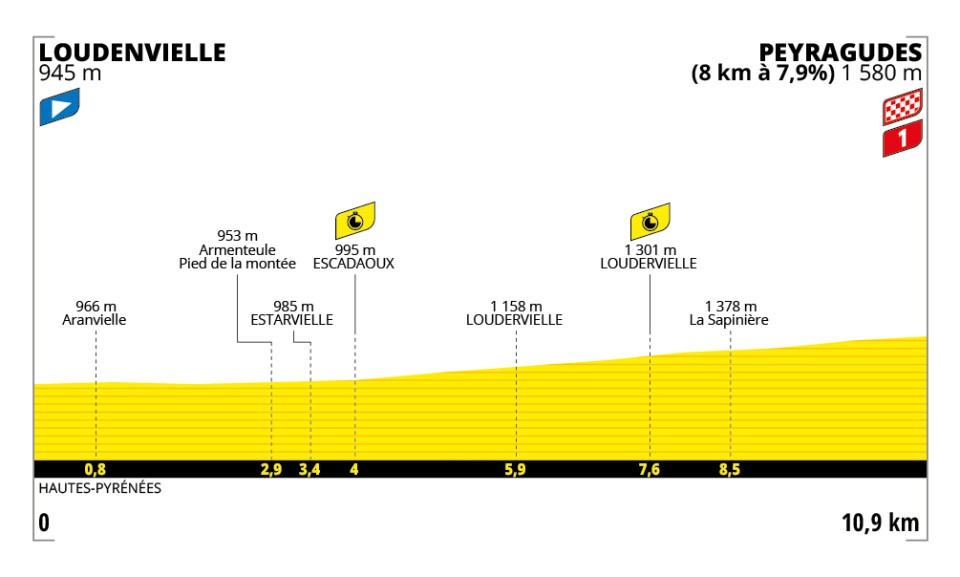
Stage 14: Pau – Luchon-Superbagneres
We stay in the mountains for stage 14 of Le Tour, which takes the peloton from Pau to Luchon-Superbagneres across four of this year’s biggest mountains.
We start with the legendary Col du Tourmalet (HC, 19 kilometres, 7.4 %), before moving on to Col d’Aspin (cat 2., 5 kilometres, 7.6 %), Col de Peyresourde (cat. 1, 7.1 kilometres, 7.8 %) and finish at Superbagneres (HC, 12.4 kilometres, 7.3 %).
The Tourmalet is the most used mountain in the history of the Tour, but this year, we climb it through Luz-Saint Sauveur, which is the least used direction of the race.
Once again, we are finishing uphill, and we are in for yet another battle for the yellow and polka dot jersey here.
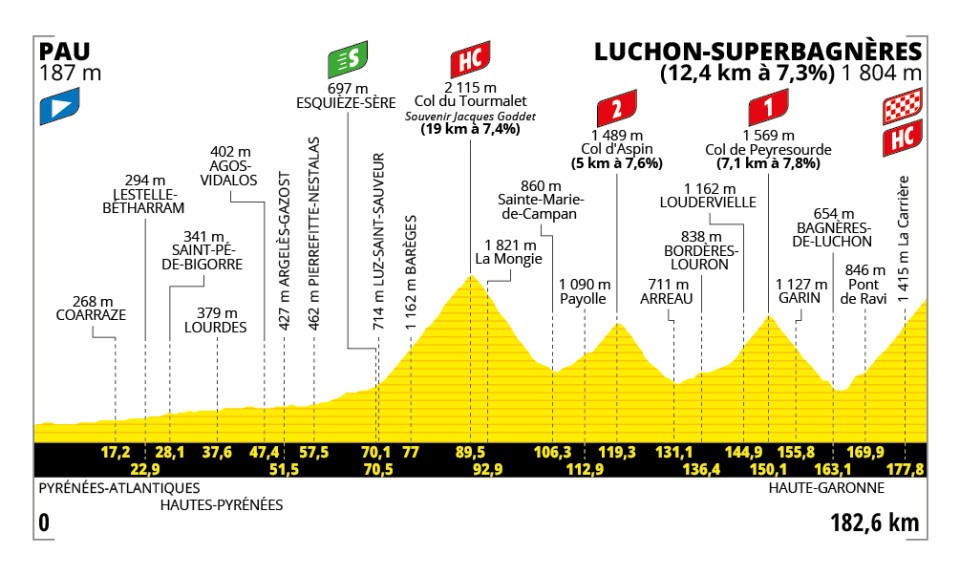
Stage 15: Muret – Carcassonne
The peloton returns to easier territory for this stage. The three mountains in the last half of the race means that it is most likely too hard for the sprinters, but it profiles excellently for a breakaway.
There are two category 3 mountains and one category two. However, they are too far away from the finish line to be used for the GC contenders, and we are thus likely to see a breakaway make it to the finish line.
When looking to place your bets on the Tour de France, you should take a look at riders that are good enough climbers to have energy left in the legs after the previous mountain stages and that are fast enough at the finish line to win a sprint between the breakaway.
After this stage comes a rest day.
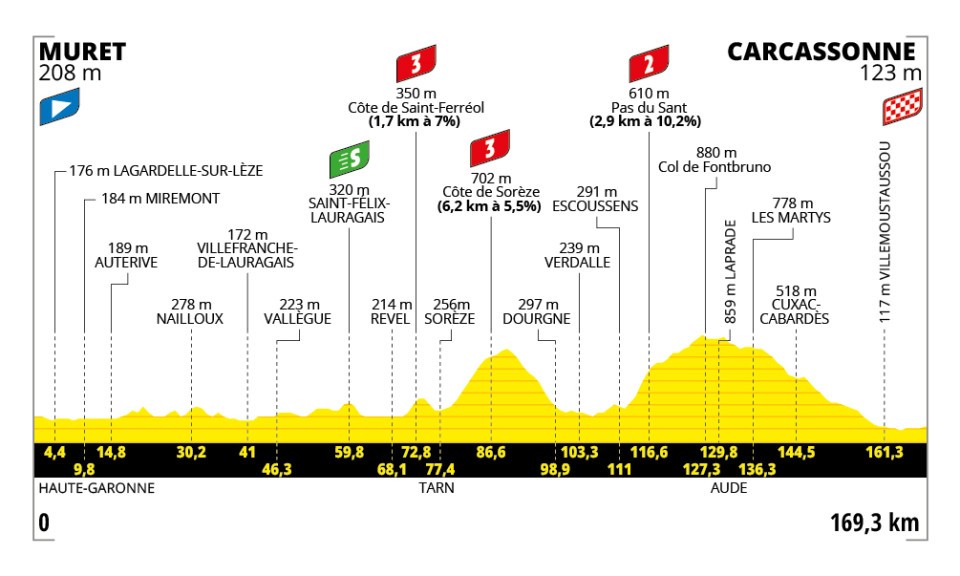
Stage 16: Montpellier – Mont Ventoux
Stage 16 is all about the ‘Naked Mountain’, Mont Ventoux. The stage is flat for the first 149 kilometres before the riders reach the lonely giant.
Mont Ventoux is legendary for the lack of trees and the steep climb, and with its 15.7 kilometres and 8.8 %, this HC climb offers a formidable ending to the stage.
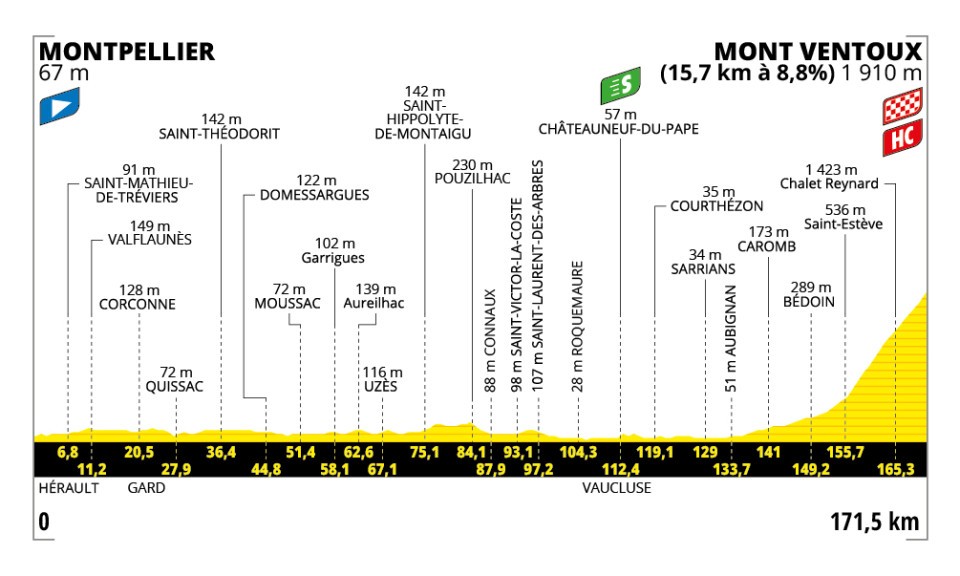
Stage 17: Bollene – Valence
After some stages for the climbers and contenders, it is time for the sprinters again at stage 17. With only two category 4 climbs, this should be a simple bunch sprint.
However, the peloton rides through some areas that are known for windy conditions, and this could provide an X factor to the otherwise predictable stage.
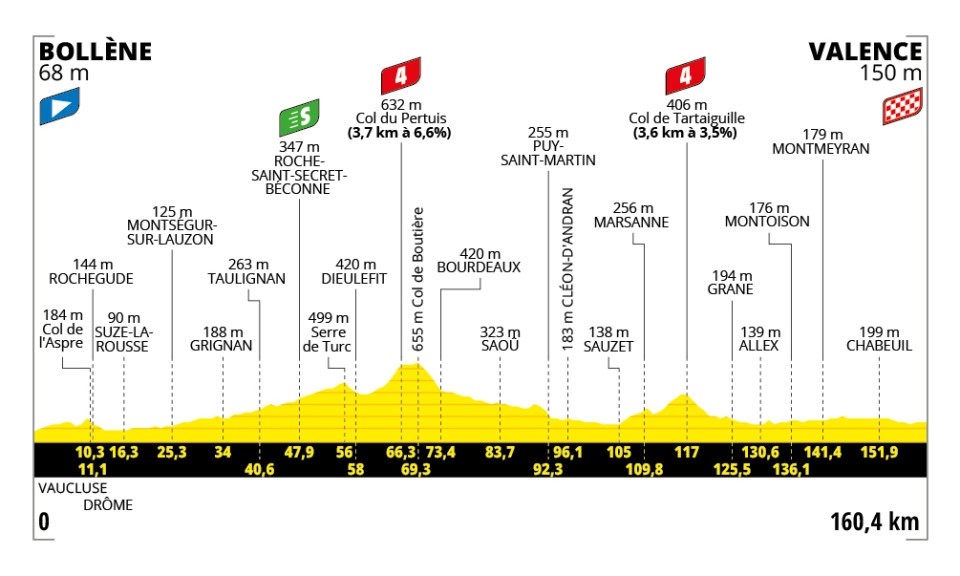
Stage 18: Vif – Courchevel Col de la Loze
Three mountains, all of them HC, is what is on the menu for Tour de France stage 18. This is the hardest stage of the entire race.
The peloton starts climbing almost immediately, and unless you are a climber, this stage is about pure survival.
First, the riders climb Col du Glandon (HC, 21.7 kilometres, 5.1 %), and then follows the legendary Col de la Madeleine (HC, 19.2 kilometres, 7.9 %). From the top of Col de la Madeleine, there are 40 kilometres to the start of the last mountain.
This means the GC contenders will most likely wait until the last mountain to make their move.
Courchevel (HC, 26.4 kilometres, 6.5 %) is a worthy finish to this brutal stage, and only the strongest of the strongest have a chance to win this stage.
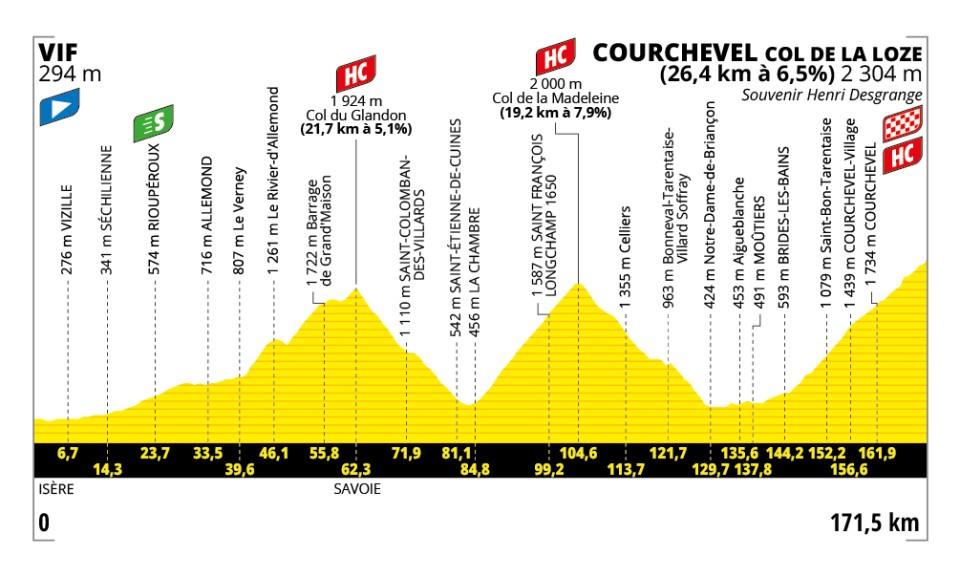
Stage 19: Albertville – La Plagnere
Yet another Tour de France stage, and yet another mountain battle. This time, the riders have to climb five mountains with little break in between each climb.
They start with Cote d’Hery-sur-Ugine (cat. 2, 11.3 kilometres, 5.1 %) and then move on to Col des Saisies (cat. 1, 13.7 kilometres), 6.4 %), Col du Pre (HC, 12.6 kilometres, 7.7 %) and Cormet de Roselend (cat. 2, 5.9 kilometres, 6.3 %).
From Cormet de Roselend there are roughly 50 kilometres to the finish line. Like on the previous stage, this makes the first mountains unlikely to attract attacks from the GC contenders. However, they will use these mountains to weaken and isolate their opponents.
The final mountain, La Plagne (HC, 19.1 kilometres, 7.2 %) marks the finish of a short stage, 129.9 kilometres, but one that is likely to be both intense and packed with action.
This is the last mountain stage of the race and the last battle for the yellow jersey. After this stage, we’ll know the winner of the race, which also means the GC riders will have to give their all to advance as high as possible.
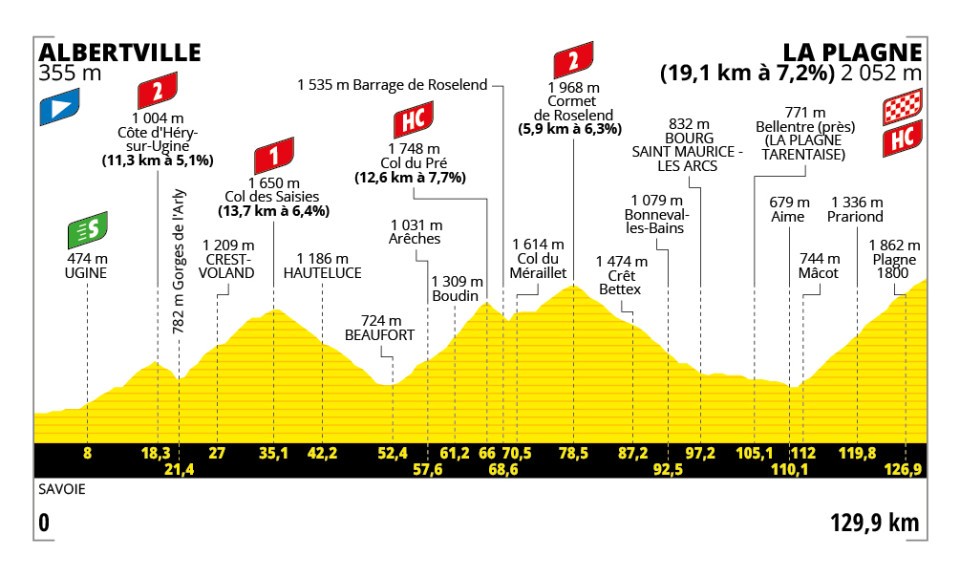
Stage 20: Nantua – Pontarlier
A hilly stage with four categorized climbs aways on the penultimate Tour de France 2025 stage. The hilly terrain means it suits break aways, but it also isn’t so hard that the sprinters don’t have a chance to win. It depends on how the sprinters have survived the previous mountain stages and if their teams can and will take the responsibility of keeping the peloton together for the bunch sprint.
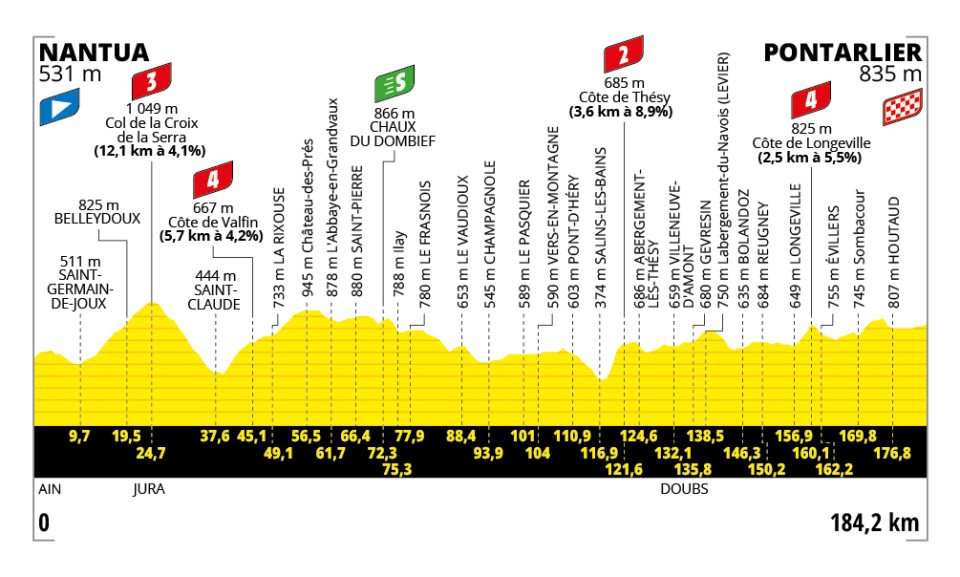
Stage 21: Mantes-la-Ville – Paris Champs-Elysees
The Tour de France returns to the Champs Elysees in Paris after last year’s hiatus to Nice due to the Summer Olympics. This also marks the 50th anniversary of the first Tour de France finish on Champs Elysees.
However, not everything is as it used to be. After last season’s exciting race at the Summer Olympics, the Tour de France copies the exciting race through the narrow streets of Paris. This means we have three steep climbs within the last 40 kilometres, and the usual bunch sprint could easily be interrupted here.
